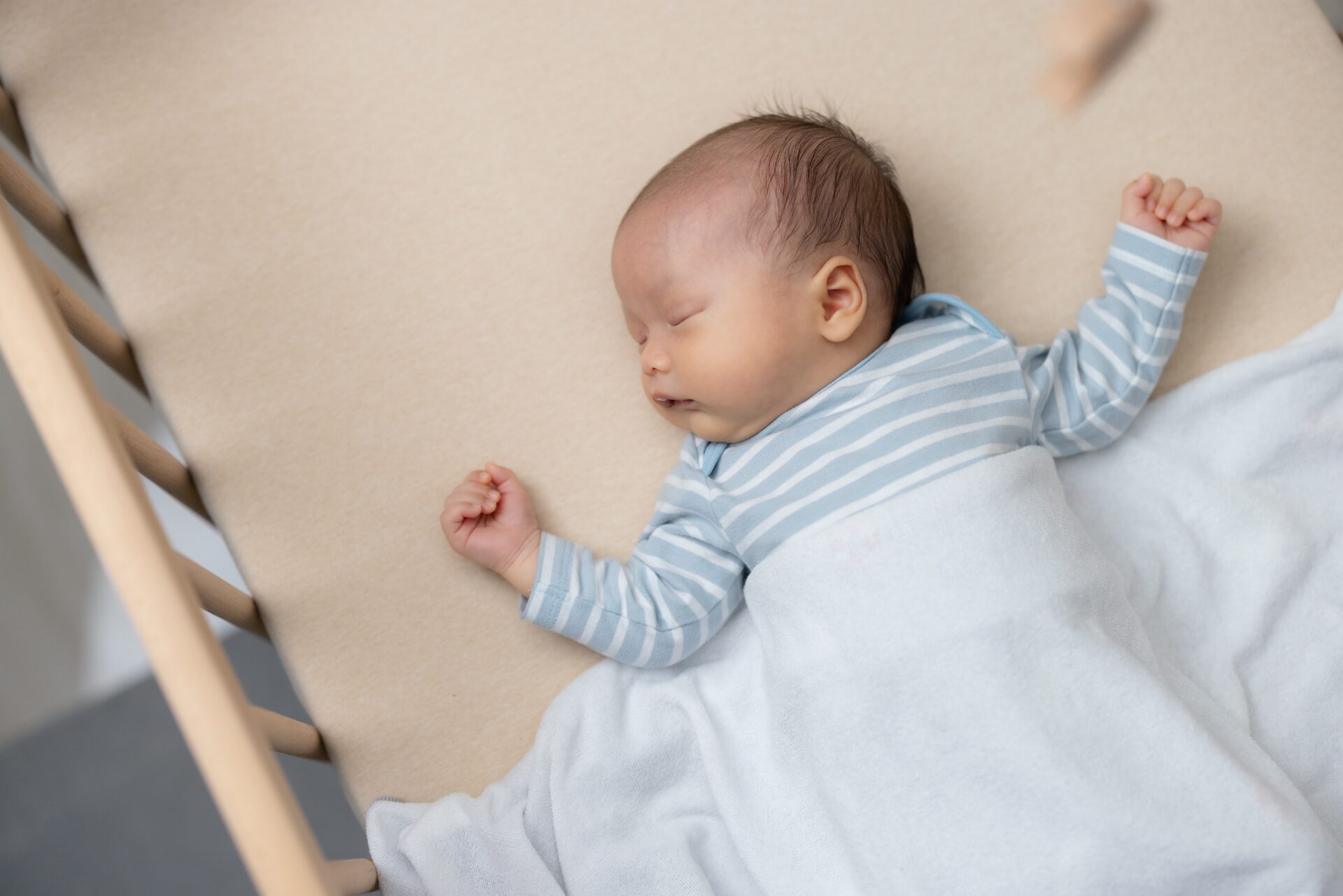Safe Sleep Practices for Your Baby
Safe sleep practices for babies involve creating an environment that minimizes sleep-related risks and supports healthy rest. By understanding these simple, research-backed guidelines, parents and caregivers can reduce the chance of accidents and enhance their baby’s well-being. Learning the best sleep positions and crib setups ensures babies sleep soundly and safely, benefiting overall health.

Why Safe Sleep Matters
Underdeveloped muscles, limited reflexes, and immature temperature regulation make babies and infants more vulnerable to safety issues during sleep. These factors help explain why certain environments pose hazards and why following safe sleep guidelines mitigates risks.
Two very important considerations for parents to consider include physiological differences and body temperature.
Physiological Differences in Infants
Babies’ quickly developing bodies put them more at risk during sleep. Weaker muscles and reflexes make it difficult to respond to breathing obstructions, while disproportionately large heads relative to body size can make it hard for them to change positions. Infants lack the strength and mobility to move away from soft bedding or escape from suffocation hazards [1].
Body Temperature
Babies are also particularly vulnerable to overheating due to difficulty regulating and maintaining a stable body temperature. Infants have a higher body surface area relative to their size, which causes internal heat to build up more quickly.
Additionally, small bodies with limited sweat glands cannot easily dissipate heat through perspiration, making it harder for babies to cool down if the room or clothing are too warm [2].
Infant Sleep Patterns by Age
Significant changes in brain maturation and the central nervous system occur during the first year of life [3]. These cognitive and physical shifts affect how much and when infants sleep, and they emphasize the importance of maintaining a safe sleep environment throughout this period of change.
Newborn Sleep
Newborns typically sleep about 16 to 17 hours daily but lack an established circadian rhythm, the internal body clock that regulates sleep and wake times [3]. Without a circadian rhythm, newborns experience fragmented sleep that occurs in short intervals throughout both day and night, rather than in one long stretch.
This irregular sleep pattern results from the newborn’s underdeveloped biological rhythms, frequent need for nourishment, and small stomach capacity that prevents long periods of uninterrupted sleep.
Importantly, frequent wakings and the transitions between active and less restful sleep make newborns more vulnerable to sleep-related risks.
One Month
By about one month of age, most babies sleep around 15.5 hours per day [3]. Sleep gradually consolidates into longer nighttime stretches, though daytime naps remain essential. Between 10 and 12 weeks of age, the first signs of a developing circadian rhythm appear, making it easier for babies to sleep longer at night.
As sleep patterns mature, caregivers may feel encouraged to let babies sleep for longer periods. However, it remains important to follow safe sleep guidelines every time a baby sleeps, day or night.
Six Months and Beyond
Sleep duration decreases to about 13 to 14 hours by six months of age [3]. Most babies can sleep through the night with one or two naps during the day. Even as sleep becomes more predictable and consolidated, safe sleep is still a priority.
Understanding Sleep-Related Infant Deaths
Infant sleep cycles and developmental vulnerabilities can increase the risk of sleep-related dangers during these early months. Each year, thousands of families experience the sudden and unexpected loss of a baby during sleep.
While research continues as to the exact causes, learning about sudden infant death syndrome (SIDS) and other sleep-related deaths helps in recognizing risks and understanding why safe sleep practices for babies are so important.
The Dangers of Sudden Infant Death Syndrome (SIDS)
Sudden infant death syndrome (SIDS) refers to the unexplained death of an otherwise healthy infant, typically during sleep and most often within the first year of life. It remains the leading cause of post-neonatal death, or death between 28 days after birth and one year of age, in the United States.
According to the Centers for Disease Control and Prevention (CDC), in 2022 alone, 1,529 infant deaths were attributed to SIDS [4].
SIDS occurs without any clear warning signs and often after an infant has been fed, changed, and put to bed without issue. Even after thorough investigations, a definitive cause is difficult to determine.
While the exact mechanisms remain unclear, research has pointed to a combination of underlying vulnerabilities in the infant’s brain, particularly in areas that control breathing and the transition from deep sleep to lighter sleep, combined with external stressors in the sleep environment [5].
Other Sleep-Related Infant Deaths
Besides SIDS, other sleep-related infant deaths include accidental suffocation, strangulation, and entrapment. These may occur when a baby’s airway is blocked by soft bedding or a caregiver’s body. It may also happen when the baby becomes wedged between objects. CDC data for 2023 shows 1,131 infant sleep-related deaths from unknown causes and 1040 from accidental suffocation and strangulation in bed [4].
These figures emphasize the urgent need for safe sleep education and consistent adherence to safe sleep guidelines.
Creating a Safe Sleep Environment
Establishing safe sleep habits is one of the most effective ways to protect a baby’s health during their most vulnerable months. The American Academy of Pediatrics (AAP) promotes the “ABCs of Safe Sleep,” a simple, evidence-based framework of baby sleep safety tips [6].
The ABCs stand for:
- Alone: Babies are safest when sleeping in their own space but near a parent’s bed.
- Back: Babies should sleep flat on their backs, which helps keep airways open and lowers the risk of suffocation.
- Crib: Babies sleep safest in a crib or bassinet that meets current safety standards.
Parents are encouraged to follow these practices consistently for at least the first 12 months to reduce the risk of sudden infant death syndrome (SIDS) and other safety concerns.
After this time, many babies gain mobility and can adjust sleep positions, but safe sleep habits remain important until the child transitions to a toddler bed.
Choosing a Safe Crib
A safe crib is structurally sound, with a snug-fitting mattress and no gaps to trap a baby’s head. Only a fitted sheet is used; there should be no bumper pads, blankets, or stuffed animals [6]. Parents can check cribs for compliance with Consumer Product Safety Commission (CPSC).
Room-Sharing vs. Bed-Sharing
The the American Academy of Pediatrics (AAP) recommends room-sharing, or placing the baby’s crib or bassinet in the parents’ bedroom, for at least six months. Ideally, it should be in the room for up to one year. Room-sharing can reduce SIDS risk by up to 50% and make nighttime monitoring and feeding easier [7].
In contrast, bed-sharing significantly increases the risks of suffocation and overlay, especially when soft bedding is present or if caregivers are overly tired or under the influence of substances.
Additionally, the risk is higher if caregivers have sleep-wake disorders such as narcolepsy, which can cause sudden, uncontrollable sleep episodes in the caregiver as well as muscle weakness.
Overall, bed-sharing is unsafe due to the increased risk of accidentally rolling onto the baby or the inability to respond promptly [7].
Establishing Healthy Sleep Habits Early for Babies
Creating clear bedtime routines and setting up a calm, secure environment at night helps support healthy sleep for babies.
Bedtime Routines
Relaxing and predictable routines signal to babies that it’s time to sleep, and they also help to create a sense of security. These routines are especially helpful when babies have trouble falling asleep, gently guiding the baby’s body and mind toward rest.
Over time, repeating the same steps each night encourages babies to fall asleep faster, stay asleep longer, and develop healthy sleep habits.
Common bedtime routines may include:
- A bath followed by feeding and bedtime
- Telling a story with a lullaby
- Quiet play before a diaper change and sleep
- Cuddling combined with breast or bottle feeding
Ideal Sleep Conditions
A comfortable and safe sleep environment is key to relaxation and reducing overheating risks. The ideal temperature for a baby’s room is between 68 and 72 degrees Fahrenheit.
Infants should be dressed in breathable sleepwear like sleepers or wearable blankets to maintain warmth without using loose blankets. Finally, it’s important to keep the infant’s head uncovered during sleep [6].
Sleep Products for Babies and Safety Concerns
Many infant sleep products claim to promote longer and safer sleep, but not all are equally safe and effective. While some are helpful, parents benefit by understanding which products are recommended, which pose potential risks, and how to use the products correctly to ensure the baby’s safety.
Safe vs. Unsafe Sleep Products
Certain infant sleep products are linked to serious safety risks, including suffocation. The Consumer Product Safety Commission (CPSC) and the American Academy of Pediatrics (AAP) strongly advise against using any sleep product that does not provide a flat, firm surface for sleep.
Items designed for lounging or propping a baby up are not safe for unsupervised sleep and can increase the risk of sudden infant death syndrome (SIDS) and suffocation.
Unsafe unsupervised sleep products include:
- Inclined sleepers
- Sleep positioners or wedges
- Soft nests or padded loungers
Baby Monitors and Sleep Tech
Monitors, breathing mats, and smart bassinets are useful infant sleep safety tools, but these items should never replace safe sleep practices.
Tech devices can give peace of mind, but may also cause undue anxiety or a false sense of security. The best protection continues to be following basic baby sleep safety tips rather than relying solely on technology [6].
Navigating Daily Challenges to Safe Sleep
From balancing family input to traveling and managing exhaustion, caregivers face many day-to-day scenarios that can affect a baby’s sleep routines and safety.
Managing Family Environments
Some well-meaning grandparents or extended family members may suggest outdated sleep practices and infant sleep safety tools. It’s important to discuss modern guidelines respectfully and emphasize that safe sleep recommendations are based on decades of scientific research.
Sharing information from the American Academy of Pediatrics (AAP) or the Centers for Disease Control and Prevention (CDC) can help bridge generational gaps and promote understanding.
Travel Tips for Safe Sleeping
Traveling with a baby brings unique challenges, from adjusting to new environments to managing unpredictable schedules. Throughout all these changes in the family’s schedule and environment, safety remains a top priority.
Portable cribs, travel-approved sleep products, and familiar sleep accessories such as the baby’s wearable blanket or sound machine offer comfort while ensuring a safe sleep space. Using these tools helps maintain consistency and supports safe sleep practices, even when routines are disrupted.
Support for Tired Caregivers
Sleep deprivation is a common challenge for new parents [8]. Although it is tempting to take shortcuts such as dozing with a baby in bed, these choices can significantly increase the risk of accidental suffocation.
Prioritizing rest and seeking support and care for sleep deprivation and any sleep problems helps caregivers stay alert and maintain safer sleep practices.
Ways to manage sleep deprivation safely include:
- Sharing nighttime duties with a spouse
- Napping when the baby naps
- Connecting with support groups or online communities
- Hiring postpartum professionals, such as doulas or night nurses
- Focusing on basic self-care, including hydration, nutrition, and mental health support
Safer Sleep and Happier Babies
Safe sleep practices help protect babies throughout the developmental stages. Using a firm, empty crib and establishing consistent bedtime routines are two ways caregivers reduce risks and create a secure sleep environment. Each thoughtful decision contributes to a safer, more restful night for both baby and family.
Scientific evidence supports these practices, just as it helps pediatric organizations develop trusted guidelines that offer peace of mind and lasting benefits. With small, consistent choices, families build safer sleep habits that lead to healthier, happier days ahead for both babies and caregivers.
- Colvin, J. D., Collie-Akers, V., Schunn, C., & Moon, R. Y. (2014). Sleep environment risks for younger and older infants. Pediatrics, 134(2), e406–e412. https://doi.org/10.1542/peds.2014-0401 Accessed 16 May 2025
- Lakhoo, D. P., Blake, H. A., Chersich, M. F., Nakstad, B., & Kovats, S. (2022). The effect of high and low ambient temperature on Infant Health: A Systematic Review. International journal of environmental research and public health. https://www.mdpi.com/1660-4601/19/15/9109. Accessed 16 May 2025.
- Tham, E. K., Schneider, N., & Broekman, B. F. (2017). Infant sleep and its relation with cognition and growth: a narrative review. Nature and science of sleep, 9, 135–149. https://doi.org/10.2147/NSS.S125992. Accessed 16 May 2025.
- Centers for Disease Control and Prevention. (2024). Data and statistics for Suid and sids. Centers for Disease Control and Prevention. https://www.cdc.gov/sudden-infant-death/data-research/data/index.html. Accessed 16 May 2025.
- Duncan, J.R., PhD, & Byard, R. W., MBBS, MD (2018). SIDS Sudden Infant and Early Childhood Death: The Past, the Present and the Future (Chapter 2). University of Adelaide Press. https://www.ncbi.nlm.nih.gov/books/NBK513399/. Accessed 16 May 2025.
- Moon, R. Y., Carlin, R. F., Hand, I., & Task Force on Sudden Infant Death Syndrome. (2022). Sleep-related infant deaths: updated 2022 recommendations for reducing infant deaths in the sleep environment. Pediatrics, 150(1). https://doi.org/10.1542/peds.2022-057990. Accessed 16 May 2025.
- Blair, P. S., Mitchell, E., Fleming, P. J., Smith, I. J., Platt, M. W., Young, J., … & Golding, J. (1999). Babies sleeping with parents: case-control study of factors influencing the risk of the sudden infant death syndrome Commentary: Cot death—the story so far. BMJ, 319(7223), 1457-1462. https://doi.org/10.1136/bmj.319.7223.1457. Accessed 16 May 2025.
- Gay, C. L., Lee, K. A., & Lee, S. Y. (2004). Sleep patterns and fatigue in new mothers and fathers. Biological research for nursing, 5(4), 311-318. https://doi.org/10.1177/1099800403262142. Accessed 16 May 2025.
The Clinical Affairs Team at MentalHealth.com is a dedicated group of medical professionals with diverse and extensive clinical experience. They actively contribute to the development of content, products, and services, and meticulously review all medical material before publication to ensure accuracy and alignment with current research and conversations in mental health. For more information, please visit the Editorial Policy.
We are a health technology company that guides people toward self-understanding and connection. The platform provides reliable resources, accessible services, and nurturing communities. Its purpose is to educate, support, and empower people in their pursuit of well-being.
Christine Dayton is a professional health writer with over a decade of experience in geriatric care and wellness, mental health, end-of-life support, and bereavement care.
Holly Schiff, Psy.D., is a licensed clinical psychologist specializing in the treatment of children, young adults, and their families.
The Clinical Affairs Team at MentalHealth.com is a dedicated group of medical professionals with diverse and extensive clinical experience. They actively contribute to the development of content, products, and services, and meticulously review all medical material before publication to ensure accuracy and alignment with current research and conversations in mental health. For more information, please visit the Editorial Policy.
We are a health technology company that guides people toward self-understanding and connection. The platform provides reliable resources, accessible services, and nurturing communities. Its purpose is to educate, support, and empower people in their pursuit of well-being.


